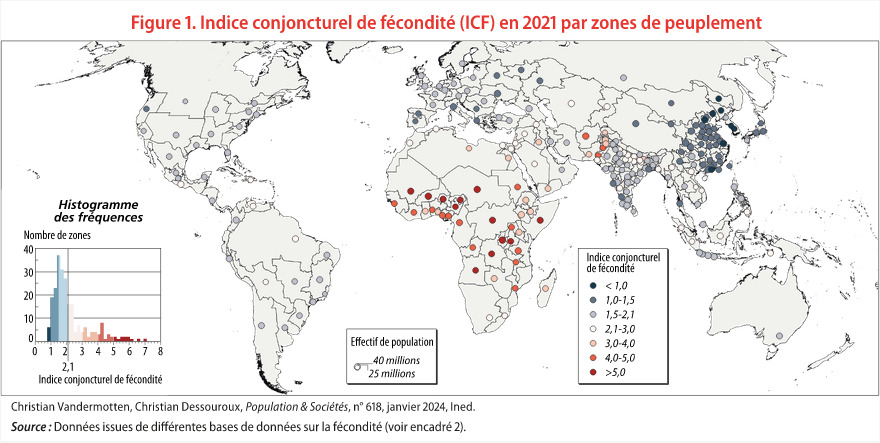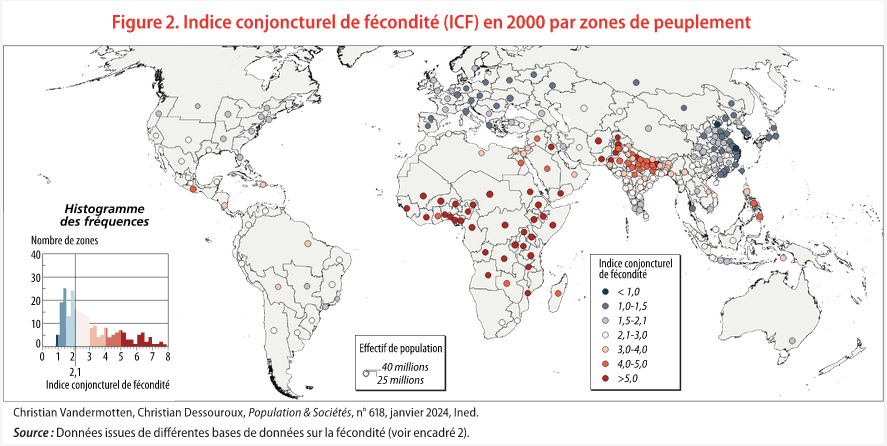Published on
Updated
Reading 2 min.
Where is fertility in the world today? What are the regions of the world where it is highest and lowest? The National Institute of Demographic Studies recently took stock of the last two decades.
As the question of the decline in the birth rate arises today in France, the National Institute of Demographic Studies is today publishing a report in the form of a map on fertility, yes, but at a global level. And the decline would not be confined only to France. Over the past 20 years, the total fertility indicator (TFR) has fallen from 2.8 to 2.3 worldwide.
The most fertile areas
Global fertility data provided by the World Population Prospects show that TFRs greater than 3 children per woman are currently only observed in a few areas of the world:
- Most of Africa;
- Some areas of the Middle East, Afghanistan and Pakistan.
ICFs of more than 5 are now only present in the Sahel, Central Africa and the Horn of Africa.
And those where the birth rate is the lowest
On the other hand, two thirds of the world’s population are now below the generation renewal threshold (2.1 children per woman), i.e. 152 of the 235 areas studied now bring together 63% of the world’s population (compared to 45% in 2000).
The lowest fertility rates are observed in:
- China’s megalopolitan coastal areas;
- Manchuria;
- South Korea, where the TFR has fallen below the threshold of 1 child per woman.
The populations of Europe and Eastern Asia, already at low fertility in the 2000s, have been joined in this category by almost the entire American continent, a large part of India, Indonesia and very recently the Philippines.


Europe, an area with low fertility
In Europe, we can also note that certain areas with very low fertility are among the rare ones in the world to have experienced a slight increase in fertility since 2000. Fertility there was already very low, falling below the generation replacement threshold from the early 1970s, or even the end of the 1960s. This was partly linked to the difficulty for women in reconciling professional life and childcare. These are Germanic Europe, northern Italy and Spain, central Europe, Ukraine and Russia.
In Western Europe, the slight recovery could be partly linked, as in Germany, to the recent influx of an immigrant population with less infertility.
France, like the interior of the United States, Australia and the southern cone of Latin America are among the areas with low fertility (ICF between 1.7 and 2) where the latter has fallen significantly, from levels still often higher than 3 children per woman in 2000.
NO to diets, YES to WW!
Areas of high fertility have almost all started to decline
Finally, last bit of information, areas with high fertility (more than 3.5 children per woman) have now become a minority (16.1% of the world population). But the new thing is that they are also experiencing remarkable and unexpected declines in fertility. A decline linked to the increase in the age of marriage and the improvement, still insufficient, in the schooling of girls and their access to the labor market, as well as the increased recourse, more or less rapid depending on the country, to contraception, often still deficient. The drop in infant mortality also reduces the “need” for births.
